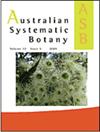澳大利亚的扁花(石蒜科)物种复合体
IF 1.6
3区 生物学
Q4 EVOLUTIONARY BIOLOGY
引用次数: 1
摘要
麻草。广泛分布于澳大利亚南部和东部,但在分类上存在不确定性。这种歧义部分是由于广泛的杂交在属,但也形态变异内部和群体之间。利用24个形态特征和59个叶绿体编码区和非编码区(~50 000 bp)对该复体进行形态学和分子分析,支持了C. flacacum与C. luteolum Traub和L.S.Hannibal ex Traub的分离,后者代表了Flinders Ranges和Lake Eyre Basin的种群。与来自默里河沿岸的南澳大利亚种群相比,在新南威尔士州洪泛平原种群中,有更大的推断遗传结构。从理论上讲,南澳大利亚种群的较大结构归因于较低的种子传播率导致较低的基因流动。本文章由计算机程序翻译,如有差异,请以英文原文为准。
The Crinum flaccidum (Amaryllidaceae) species complex in Australia
ABSTRACT Crinum flaccidum Herb. is widespread across southern and eastern Australia, but suffers from taxonomic uncertainty. This ambiguity is in part due to widespread hybridisation in the genus, but also morphological variability within and among populations. Morphological and molecular analyses of the complex using 24 morphological characters and 59 chloroplast coding and non-coding regions (~50 000 bp) provided support for the separation of C. flaccidum from C. luteolum Traub & L.S.Hannibal ex Traub, with the latter representing populations from the Flinders Ranges and Lake Eyre Basin. Within Crinum flaccidum, there was greater inferred genetic structure at the population level for New South Wales flood plain accessions, compared with South Australian populations from along the Murray River. The greater structure of the South Australian populations is theorised to be attributed to lower seed-dispersal rates leading to lower gene flow.
求助全文
通过发布文献求助,成功后即可免费获取论文全文。
去求助
来源期刊

Australian Systematic Botany
生物-进化生物学
CiteScore
3.10
自引率
12.50%
发文量
12
审稿时长
>12 weeks
期刊介绍:
Australian Systematic Botany is an international journal devoted to the systematics, taxonomy, and related aspects of biogeography and evolution of all algae, fungi and plants, including fossils. Descriptive taxonomic papers should normally constitute a comprehensive treatment of a group. Short papers on individual species and nomenclatural papers must contain significant new information of broader interest to be considered. The prestigious L.A.S. Johnson Review Series is published. Other review articles will also be considered. All papers are peer reviewed.
Australian Systematic Botany is published with the endorsement of the Commonwealth Scientific and Industrial Research Organisation (CSIRO) and the Australian Academy of Science.
 求助内容:
求助内容: 应助结果提醒方式:
应助结果提醒方式:


